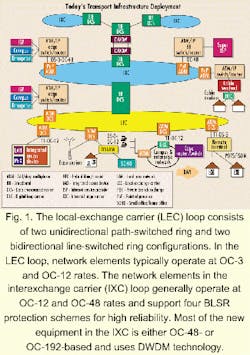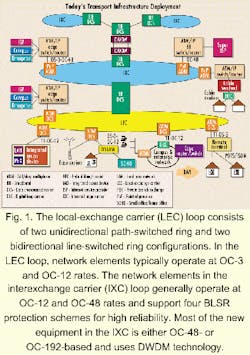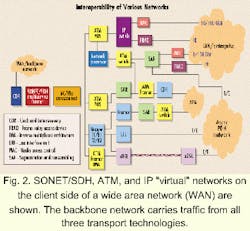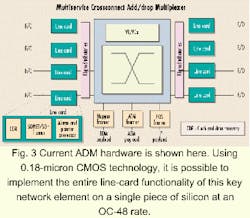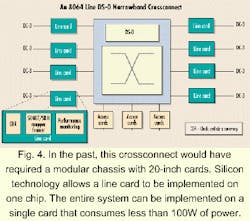Multiservice networks will demand systems-on-silicon
Network equipment vendors will soon follow in the steps of the computer industry, moving communications hardware functionality to silicon.
Pundits debate what next-generation networks will look like. A few things are clear, however. Data is dramatically shifting the network paradigm. Meanwhile, the existing copper plant and Synchronous Optical Network/Synchronous Digital Hierarchy (SONET/ SDH)-based network equipment is not going to disappear in the foreseeable future, although it will be phased out very slowly. Finally, the shift toward data services such as Internet access has incumbent carriers and emerging service providers racing to build competitive multiservice (voice, video, and data) networks.
The complexity of the network equipment required to support these communications infrastructures is causing vendors to begin to move hardware functionality to silicon. Notably, a similar migration is ongoing in the computer industry as systems become increasingly smaller and more complex.
In the past, asynchronous and Plesiochronous Digital Hierarchy (PDH) communication technologies dominated backbone, access, and customer-premises applications. These technologies were relatively inflexible and restrictive, limiting control and management of the network. Customers' demands for flexibility in service, higher bandwidth, and protection forced service providers to seek better solutions.
In the 1980s, SONET/SDH emerged as the preferred technology, which enabled a higher degree of network control, provisioning, and visibility of small-granularity channels. International standards ensured compatibility between synchronous and asynchronous communication technology and paved the way for large-scale deployment of SONET/SDH-based equipment.
Today, telecommunications, cable, and data-communications markets are experiencing rapid growth. The Internet, corporate intranets, digital-subscriber-line (xDSL) services, digital television, and wireless-communication services are fueling this explosive growth.
The Internet is the "killer application," driving an insatiable need for bandwidth in both the subscriber loop and the backbone. By some estimates, the bandwidth demand due to Internet traffic is doubling every few months. Market research firm RHK Inc. estimates that data bandwidth will outpace voice in public networks by 30:1 before 2003. These opportunities together with the Telecommunications Act of 1996 have opened the door for Internet service providers (ISPs), multiservice operators, and competitive access providers (CAPs) such as cable operators. In addition to data services, many of these service providers are starting to offer traditional voice services such as Internet telephony, and facsimile. Conversely, regional Bell operating companies (RBOCs) and long-distance carriers have begun to offer such data services as Internet access.
Expanded use of local telephone loops to access the ISPs is causing severe congestion in the voice networks, posing a threat to the quality of service (QoS) expected by customers. This problem is addressed, in some regions, by xDSL access technology. Current DSL services are capable of bandwidths from 128 kbits/sec through 52 Mbits/sec for voice, video, and data applications.
Another access solution is cable technology. The existing cable plant, however, was not designed for two-way communication, nor is it of high enough quality to support data communication using cable modems. Thus, cable operators are aggressively upgrading their plant by using high-speed fiber-based technology to offer broadband data services. Hybrid-fiber coaxial networks, fiber-in-the-loop, and switched digital-video technology are examples of this effort.
The insatiable need for bandwidth in the subscriber loop has caused a severe bottleneck in the local-exchange carrier (LEC) loop, which in turn has caused a congestion problem in the interexchange carrier (IXC) loop. Exasperating the situation, the bandwidth requirements at the LEC and the IXC level are likely to grow exponentially for the next several years.Figure 1 illustrates equipment deployment in today's transport infrastructure. The network elements in the LEC loop typically operate at OC-3 (155-Mbit/sec) and OC-12 (622-Mbit/sec) rates. The LEC loop consists of 2-fiber unidirectional path-switched ring or 2-fiber bidirectional line-switched ring (BLSR) configurations.
The network elements in the IXC loop generally operate at OC-12 and OC-48 (2.5-Gbit/sec) rates and support 4-fiber BLSR protection schemes for high reliability. All or most of the new equipment in the IXC is either OC-48 or OC-192 (10-Gbit/sec) based and uses dense wavelength-division multiplexing (DWDM) technology. In a given geographic region, there may be one or more LECs and IXCs.
From the point of view of end-to-end service deployment, voice, video, and data-network convergence is finally becoming a reality. The end-to-end network, however, remains fragmented. Various incumbent and competitive LECs and IXCs own some portion of the transport infrastructure. Some wholesale bandwidth providers don't offer switching. Many ISPs and CAPs have data-switching equipment, but don't own any transmission gear.
This fragmented landscape is fueling intense competition. Many incumbent and competitive service providers are positioning themselves to provide customers with multiple services. A number of IXCs not only provide long-distance services to business customers, they also offer lower-speed services such as DS-3s (44.736 Mbits/sec) and completely bypass the RBOCs. Similarly, cable operators such as AT&T (formerly TCI) offer ISP services, posing an additional threat to the RBOCs. With its backbone infrastructure already in place and its wired access to over 30 million U.S. households through its cable operations, AT&T is in a position to provide true end-to-end broadband voice, video, and data service.
To best exploit the market opportunities of the ongoing communications revolution, many service providers have deployed solutions based on SONET/SDH, Asynchronous Transfer Mode (ATM), and Internet-protocol (IP) technology. Each of these protocols is vying to be the technology of choice for multiservice transport. Figure 2 illustrates the interoperability of these networks on the client side. The backbone network carries traffic from all three technologies. A common solution is to use an overlay network where one physical infrastructure is broken into separate virtual networks for voice and data.Each of the technologies, SONET/SDH, ATM, and IP, offer unique advantages. On the market for more than a decade, SONET/SDH today provides interoperability, survivability, reliability, manageability, and low (less than 5%) overhead. It is the standard network technology used by carriers for voice services. It also supports legacy technologies.
In the telecommunications market, it takes a long time for a technology to become ubiquitous and even longer for a technology to become totally obsolete. Today's telephone system must still support pulse dialing, even though touch-tone was invented several decades ago. Likewise, the existing copper plant is not going to disappear anytime in the foreseeable future.
Nonetheless SONET/SDH was developed with circuit-switched topologies in mind. It has been retrofitted by many carriers to carry data services.
ATM offers advantages in that it is truly able to carry multiservices (voice and data) and it can ensure QoS. For data services, however, ATM has a relatively high overhead, or "cell tax."
IP offers the most efficient utilization of bandwidth for data. Despite development efforts, however, this technology still does not support QoS, a requirement for latency-critical services such as voice. In addition, network throughput is limited by the packet processing speed of the network elements.
A common misconception is that emerging technologies are replacing SONET/SDH. Many in the industry discuss IP transport over fiber, which would bypass SONET/SDH. While IP directly over DWDM is possible in principle, it still requires major functions that today are only provided by SONET/SDH, such as maintenance flows and protection switching. While IP over DWDM might be a viable solution for a high-speed backbone in the case of a point-to-point connection between two terabit routers, it doesn't answer the serviceability needed in the access network. Moreover, in a number of developing countries, telephony infrastructure that will use traditional SONET/SDH boxes still needs to be built.
The role of SONET/SDH in the public networks is evolving, however. As network traffic shifts from voice to primarily data, SONET/SDH functionality is increasingly incorporated into networking gear like DWDM systems, switches, and routers at the interface level.
The prohibitive cost and impracticality of replacing all of the existing infrastructure to support a new technology, the inherent advantages of each protocol, and the different needs of various geographic areas will require many networks to support SONET/SDH, ATM, and IP. For the next several years, the challenge for carriers and equipment vendors is not only to support these technologies, but also to allow them to coexist on one virtual network in a highly flexible manner.
With the exception of the core transport, which is likely to be DWDM-based, next-generation broadband transport equipment will require the following attributes:
- Flexible interface support for Ethernet, IP, and ATM
- Highly provisional bandwidth for different interfaces, from DS-1 through OC-192
- One network-management system for all equipment
- The ability to interface with older equipment
- Interoperability between different equipment vendors
- High-speed data processing handling different services/billing of the end customer.
These requirements present several downsides. The first is hardware and software complexity. Broadband transport over multiprotocols will demand ever-increasing speeds, both inside the equipment and at the interfaces, which results in hardware complexity and power dissipation. Another drawback is the increased size and power dissipation of the gear, which has an adverse effect in the carrier space. More often than not, the carrier plant building is a fixed structure. Therefore, space in the building is a precious commodity. Finally, with increasing competition, there is time-to-market pressure, made more difficult by the complex equipment.
The demands placed on next-generation transport equipment—increased functionality, flexibility, and speed combined with reduced size, power, cost, and development cycles—is causing some vendors to move hardware functionality to silicon and to migrate higher layer functions such as QoS, policy, and management to system software. Silicon offers increased throughput and functionality, while simultaneously reducing size, power, and cost.
Although complex function design in silicon using state-of-the-art tools requires large investments in research and development, once a single copy of the silicon is achieved, the cost of these devices is very low in volume. With standardization of system and silicon interfaces, original equipment manufacturers (OEMs) will have silicon choices from multiple vendors. Likewise, silicon vendors can amortize their research and development costs by selling to more OEMs. Moreover, design reuse is a common process in the silicon industry. By using a building-block approach, silicon vendors simultaneously reduce research and development costs and shorten development cycles.
The move to silicon and the standardization of interfaces also occurred in the maturing PC industry. The result has been a continual increase in system performance with simultaneous reduction in cost and development cycles.
A number of the silicon components required to build next-generation multiservice networking gear are listed below. This list is based on the premise that for the next three to five years, the underlying physical transport interface will be SONET/SDH-based and that ATM and IP traffic will be carried over SONET/SDH. An IP or an ATM-based network, however, is also consistent with this model.
- Optics modules that provide access to the fiber
- Physical-layer devices comprised of clock, data recovery, and serializing/ de-serializing circuitry
- Multiservice SONET/SDH framer
- Pointer and alarm processor to compensate for frequency difference
- Highly integrated crossconnect fabric
- ATM and IP over SONET/SDH mappers
- Highly integrated t1/e1/t3/e3 mapper/ framers
- ATM and IP switching fabrics
- Hardwired or programmable "network processors" for Layers 2, 3, and higher
- Multiservice backplanes
- Segmentation and reassembly.
Figure 4 is an example of an 8064-line narrowband crossconnect. This crossconnect is a key element of a Class 5 telecommunications switch. In the past, this system would have required a modular chassis with 20-inch cards to implement. Current silicon technology allows an entire line card to be implemented on one chip. Therefore, the entire system can be implemented on a single card that consumes less than 100W of power.
Service providers, equipment manufacturers, and silicon vendors are joining forces to develop solutions for a virtual network that is data centric. Vendors' efforts to move hardware functionality to silicon will continue, and increasing device complexity will result in entire systems put on silicon.
This paradigm has an interesting implication. Typically, system design follows a top-down methodology, where it flows from system specification through system architecture to hardware implementation. In a system-on-silicon paradigm, the system architecture begins with silicon. Therefore, from an end user's perspective, the cost of new services will be lower, or the same as it is today, and system reliability will be at least as good as it is now. In the final analysis, the network operators, service providers, equipment manufacturers, integrated circuit providers, and the end users all stand to reap the benefits of this technology convergence.
Deepak Rana is senior director, broadband at Level One Communications Inc. (San Francisco).
